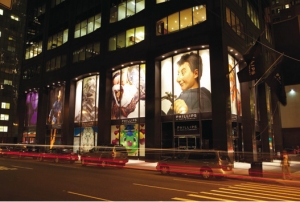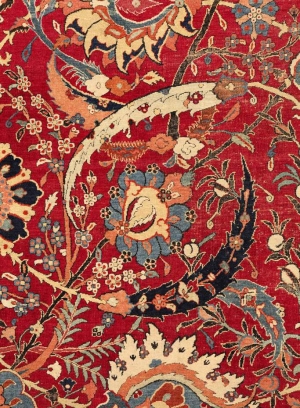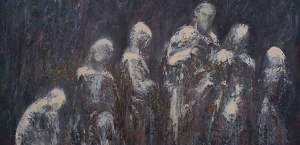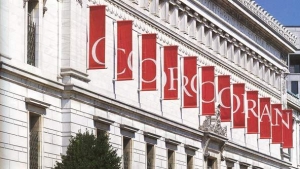|
Displaying items by tag: deaccession
It was "another white glove sale" Wednesday of items from the collection of the former Higgins Armory Museum at Thomas Del Mar Ltd in London, the auction house said.
The second and final "de-accession" sale of the Higgins collection Wednesday raised £830,000, or $1.4 million in U.S. currency, with 100 percent of the items sold. The first sale last year brought in £1.2 million. In U.S. currency, the combined amount is more than $3.4 million.
The Delaware Art Museum in Wilmington is trying to track down a group of visitors who recently vandalized a number of the institution’s works with stickers. The stickers, which feature some religious script and imagery, were placed on a number of Pre-Raphaelite paintings and an outdoor statue. Other stickers with a large red “T” were also placed on the paintings.
The vandals were captured on the museum’s security cameras, but attempted to hide their identities. The stickers have been successfully removed by a painting conservator, but the amount of damage done to the collection is unknown. The Delaware Art Museum has one of the most celebrated collections of Pre-Raphaelite art outside of Britain.
In March, the Delaware Art Museum announced that it would deaccession four works from its collection to pay off its $19.8 million bond debt and replenish its endowment. The institution has not specified which works it plans to sell.

The Delaware Art Museum in Wilmington announced on Wednesday that it had decided to sell up to four works from its collection, to save the museum from closing. The institution found itself in grave bond debt following an expansion and renovation in 2005. The museum did not specify which works it plans to sell, but said that it expected to bring in $30 million from the sale, which is enough to pay off the institution’s $19.8 million bond debt and renew its endowment.
The Delaware Art Museum’s Chief Executive Officer, Mike Miller, released an official statement saying, “After detailed analysis, heavy scrutiny and the exhaustion of every reasonable alternative to relieve our bond debt, the Trustees had two agonizing choices in front of them — to either sell works of art, or to close our doors. While today’s decision is certainly hard to bear, the closure of this 100-year-old museum would be, by comparison, unbearable.”
Miller went on to explain that repayment terms for tax-exempt bonds issues in 2003 for the expansion of the institution’s historic Kentmere Park building became accelerated due to restrictive banking regulations, causing the museum to default on performance covenants. At the same time, the museum’s endowment dwindled as a result of stock market performance, forcing the Trustees to make significant budget cuts, including staff layoffs and funding cuts for exhibitions.
The Delaware Art Museum, which focuses on American art of the 19th through the 21st centuries and English Pre-Raphaelite art of the mid-19th century, expects the sale to be finalized in the next six months.

This fall, Phillips will sell photographs from the Art Institute of Chicago’s illustrious collection. Works by Robert Frank, Henri Cartier-Bresson, Edward Weston and Irving Penn will be offered during sales in October in New York and in November in London.
The Art Institute of Chicago began organizing photography exhibitions in 1900 and has been building its own collection for nearly 65 years. Ellen Sandor, Chair and Curator of the Art Institute of Chicago’s photography department, said, “In 2014 we celebrate our fortieth anniversary as a separate curatorial department and the fifth anniversary of our dedicated galleries in the Art Institute’s Modern Wing. Those two anniversaries represent continuity and change—both essential to our progress. We have spent three and a half years to assess our holdings, with a view to refining and diversifying the collection as well as better understanding the treasures that we possess. Proceeds from the sale will support future acquisitions, and we are grateful to Phillips for working with such care and consideration on this sale.”
The two sales will be complemented by an online selling exhibition in December. Highlights from the collection will go on view in New York, Chicago and London prior to the sales.

On June 5, 2013 at Sotheby’s New York the Corcoran Gallery of Art auctioned 25 rugs from its William A. Clark Collection. The rugs, which are from the 16th and 17th centuries, brought in $43.7 million, over four times the pre-sale high estimate of $9.6 million, making it the most successful carpet auction ever held. 100% of the lots sold and the auction achieved “White Glove” status, meaning every lot in the sale garnered more than it’s pre-sale high estimate.
The highlight of the auction was the Clark Sickle-Leaf Carpet. An important and iconic rug created by an unknown Persian artist during the first half of the 17th century, the rarely exhibited piece was expected to garner between $5 million and $7 million. The carpet ended up selling for $33.7 million, the highest price paid for any carpet at auction. Mary Jo Otsea, the senior consultant for rugs and carpets at Sotheby’s said, “Selling the Clark Sickle-Leaf Carpet for a record-breaking price of more than three times the previous auction record for a carpet has unquestionably been the highlight of my 30 year career. It is gratifying to see the strength of the market for carpets of this quality and rarity.”
The rugs were part of a bequest from William Clark (1839-1925), a Montana-based entrepreneur-turned-senator, to the Corcoran in 1925. The gift was comprised of 200 paintings and drawings and a number of other works, including the rugs. The Corcoran will use the proceeds from the sale to support future acquisitions that will better fit the institution’s focus on American and contemporary art. While the Corcoran has endured recent financial troubles, the money will not be used for operating expenses in keeping with its deaccession policy.

The Georgia Museum of Art at the University of Georgia is hosting the show Deaccessioning Bernard Smol (1897-1969), which is putting a unique spin on the standard museum exhibition. Due to limited storage space and an evolving collection, the museum has decided to deaccession all but one of Smol’s works. Visitors to the exhibition will vote for the piece that they would like to remain in the museum’s collection and curatorial staff will work this feedback into their final decision.
The process of deaccessioning artworks is lengthy and closely regulated. A museum must make the public aware of its intent and the museum’s collections committee and Board of Advisors must approve that intent. Only when all parties are on board is a work able to be removed from a collection. Oftentimes, the artwork heads to auction and the proceeds from the sale are used for future acquisitions that will bolster the museum’s collection.
Deaccessioning Bernard Smol presents five oil paintings by the French artist, which have not been shown at the Georgia Museum since their initial exhibition in 1959. The Georgia Museum was inspired by DePaul University’s exhibition, The Good the Bad, and the Ugly, which helped them decide what works to deaccession from their own collection in 2010.

On June 5, 2013 the Corcoran Gallery of Art in Washington, D.C. will auction 25 rugs from its William A. Clark Collection at Sotheby’s New York. The rugs, which are from the 16th and 17th centuries, are estimated to bring as much as $9.6 million.
The rugs were part of a bequest from William Clark (1839-1925), a Montana-based billionaire entrepreneur-turned-senator, to the Corcoran in 1925. The gift was comprised of 200 paintings and drawings and a number of other works, including the rugs.
The Corcoran will use the proceeds from the sale to support future acquisitions that will better fit the institution’s focus on American and contemporary art. While the Corcoran has endured recent financial troubles, the money will not be used for operating expenses in keeping with its deaccession policy.
Highlights from the Corcoran sale include the Clark Sickle-Leaf Carpet, which is expected to garner between $5 million and $7 million. An unknown Persian artist created the rug during the first half of the 17th century possibly for the shah. The rarely exhibited Sickle-Leaf is one of the most iconic and important carpets to appear at auction. Another rug known as the Lafoes Carpet, which measures 44 feet long, is expected to bring between $800,000 and $1.2 million.
A vintage print of a photograph by Edvard Munch (1863-1944), which is now in the collection of the Munch Museum in Oslo, might be headed to the Centre Pompidou in Paris. One of an edition of five, the photograph shows Munch in his garden around 1930. The work was part of the collection that Munch bequeathed to the city of Oslo.
Last month, the city’s government asked Oslo’s parliament to approve the deaccession of the photograph so that it could be sold to a major international institution and made more accessible to the public. In response to the proposal, a member of Parliament pointed out that the deaccession is in contrast to Munch’s will that states that his works should be kept together. While a long-term loan is a possibility, city officials are asking Parliament to vote on the Munch sale.
The Centre Pompidou has offered nearly $50,000 for the print. The Oslo government expects a decision to be made in 2013.
|
|
|
|
|